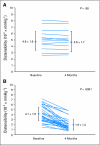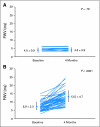Aortic stiffness increases upon receipt of anthracycline chemotherapy
- PMID: 19901105
- PMCID: PMC2799231
- DOI: 10.1200/JCO.2009.23.8527
Aortic stiffness increases upon receipt of anthracycline chemotherapy
Abstract
PURPOSE Cancer survivors exposed to anthracyclines experience an increased risk of cardiovascular (CV) events. We hypothesized that anthracycline use may increase aortic stiffness, a known predictor of CV events. PATIENTS AND METHODS We performed a prospective, case-control study involving 53 patients: 40 individuals who received an anthracycline for the treatment of breast cancer, lymphoma, or leukemia (cases), and 13 age- and sex-matched controls. Each participant underwent phase-contrast cardiovascular magnetic resonance measures of pulse wave velocity (PWV) and aortic distensibility (AoD) in the thoracic aorta at baseline, and 4 months after initiation of chemotherapy. Four one-way analyses of covariance models were fit in which factors known to influence thoracic aortic stiffness were included as covariates in the models. Results At the 4-month follow-up visit, aortic stiffness remained similar to baseline in the control participants. However, in the participants receiving anthracyclines, aortic stiffness increased markedly (relative to baseline), as evidenced by a decrease in AoD (P < .0001) and an increase in PWV (P < .0001). These changes in aortic stiffness persisted after accounting for age, sex, cardiac output, administered cardioactive medications, and underlying clinical conditions known to influence aortic stiffness, such as hypertension or diabetes (P < .0001). CONCLUSION A significant increase in aortic stiffness occurs within 4 months of exposure to an anthracycline which was not seen in an untreated control group. These results indicate that previously regarded cardiotoxic cancer therapy adversely increases thoracic aortic stiffness, a known independent predictor of adverse cardiovascular events.
Conflict of interest statement
Authors' disclosures of potential conflicts of interest and author contributions are found at the end of this article.
Figures



Similar articles
-
Early and late changes in markers of aortic stiffness with breast cancer therapy.Intern Med J. 2015 Feb;45(2):140-7. doi: 10.1111/imj.12645. Intern Med J. 2015. PMID: 25404097
-
Anthracycline causes impaired vascular endothelial function and aortic stiffness in long term survivors of childhood cancer.Pathol Oncol Res. 2013 Jul;19(3):375-83. doi: 10.1007/s12253-012-9589-6. Epub 2012 Dec 16. Pathol Oncol Res. 2013. PMID: 23242567
-
Incremental prognostic value of aortic stiffness in addition to myocardial ischemia by cardiac magnetic resonance imaging.BMC Cardiovasc Disord. 2020 Jun 11;20(1):287. doi: 10.1186/s12872-020-01550-w. BMC Cardiovasc Disord. 2020. PMID: 32527291 Free PMC article.
-
Effects of anthracyclines on aortic distensibility in patients with lymphomas: a prospective study.Hellenic J Cardiol. 2014 May-Jun;55(3):191-6. Hellenic J Cardiol. 2014. PMID: 24862610
-
Time-Dependent Effect of Anthracycline-Based Chemotherapy on Central Arterial Stiffness: A Systematic Review and Meta-Analysis.Front Cardiovasc Med. 2022 Jul 5;9:873898. doi: 10.3389/fcvm.2022.873898. eCollection 2022. Front Cardiovasc Med. 2022. PMID: 35865379 Free PMC article.
Cited by
-
Cancer Therapy and Exercise Intolerance: The Heart Is But a Part: JACC: CardioOncology State-of-the-Art Review.JACC CardioOncol. 2024 Jun 4;6(4):496-513. doi: 10.1016/j.jaccao.2024.04.006. eCollection 2024 Aug. JACC CardioOncol. 2024. PMID: 39239327 Free PMC article. Review.
-
Understanding cardiovascular injury after treatment for cancer: an overview of current uses and future directions of cardiovascular magnetic resonance.J Cardiovasc Magn Reson. 2013 Jul 31;15(1):66. doi: 10.1186/1532-429X-15-66. J Cardiovasc Magn Reson. 2013. PMID: 23902649 Free PMC article. Review.
-
Metastatic malignancies and the effect on arterial stiffness and blood pressure levels: the possible role of chemotherapy.Onco Targets Ther. 2018 Oct 11;11:6785-6793. doi: 10.2147/OTT.S156318. eCollection 2018. Onco Targets Ther. 2018. PMID: 30349311 Free PMC article.
-
Assessment of Cardiotoxicity of Cancer Chemotherapy: The Value of Cardiac MR Imaging.Magn Reson Imaging Clin N Am. 2019 Aug;27(3):533-544. doi: 10.1016/j.mric.2019.04.001. Magn Reson Imaging Clin N Am. 2019. PMID: 31279455 Free PMC article. Review.
-
A penetrating atherosclerotic ulcer rapidly growing into a saccular aortic aneurysm during treatment of leukaemia: a case report.Eur Heart J Case Rep. 2021 Jul 12;5(7):ytab196. doi: 10.1093/ehjcr/ytab196. eCollection 2021 Jul. Eur Heart J Case Rep. 2021. PMID: 34514296 Free PMC article.
References
-
- Floyd JD, Nguyen DE, Lobins RL, et al. Cardiotoxicity of cancer therapy. J Clin Oncol. 2005;23:7685–7696. - PubMed
-
- Yeh ET, Tong AT, Lenihan DJ, et al. Cardiovascular complications of cancer therapy: Diagnosis, pathogenesis, and management. Circulation. 2004;109:3122–3131. - PubMed
-
- Singal PK, Iliskovic N. Doxorubicin-induced cardiomyopathy. N Engl J Med. 1998;339:900–905. - PubMed
Publication types
MeSH terms
Substances
Grants and funding
LinkOut - more resources
Full Text Sources
Other Literature Sources
Medical

